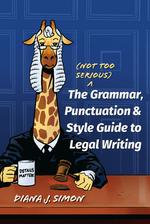Research and recommendations for transitions
In a recent article, Professor Diana J. Simon of the University of Arizona James E. Rogers College of Law gathered results from some empirical studies on the use of “connectives” (what I’d call “transitions”) in writing. Prof. Simon’s article is called, “The Power of Connectivity,”[1] and the advice is informative and valuable to legal writers who want to write readable, easily comprehensible prose.
Research by psycholinguists and cognitive psychologists shows that transitions in writing improve reader comprehension and even speed up reading and understanding.[2] Some of the research is basic and aligns with common sense: in one study, connecting two related sentences with the word “because” resulted in faster comprehension than the same two sentences without the connecting “because.”[3]
In another study, participants were given equal time to read multiple pairs of sentences. But one group read pairs connected with “because,” one group read pairs connected with “and,” and the third group read pairs with no connectives. When asked to write down what they remembered, recall was better for those who read the “because” pairs than for the other two groups.[4]
And one study asked participants to read four technical essays and then take a 10-question quiz about the content. Half the essays contained “logical connectives,” and half did not. The test scores were higher for those who read the connected essays, leading the researchers to conclude that “logical connectives appear to aid readers in understanding expository prose.”[5]
Professor Simon then describes transitions (connectives) as mainly linking or substantive. Understanding these two kinds of transitions can help us write connected prose.
Linking transitions are the most common type, and are well known to legal writers. They connect one idea or concept to another and show relationships. Here are some relationships with examples of linking transitions: addition (further, also), causation (therefore, thus), comparison (similarly, likewise), contrast (however, but), and sequence (first, second, third). Granted that these transitions are basic, nearly all legal writing could be improved by more and better use of linking transitions.
Substantive transitions show substantive links between ideas. Professor Simon focuses on three subcategories: repetition, restatement, and roadmapping.[6]
Repetition means literally repeating a key word or phrase from a previous sentence or paragraph, and when not overdone, creates connections in the reader’s mind. For example, when writing about a claim of premises liability, it would be unwise to refer to the claim as “premises liability” and then later “premises defect,” and later “owner liability.” That’s confusing. By repeating the key term, premises liability, the writing stays connected, easing the reader’s way.
Professor Simon notes that even the way we use cases employs repetition:
When the defendant is a governmental entity, a statutory prerequisite may be jurisdictional. Key v. ABC Co., 123 S.W.3d 456, 457 (Tex. 2000). In Key, the court used a three-step test to determine what is a jurisdictional prerequisite. Id.
The repeated case name, Key, creates the connection.
Restatement means recasting a concept for efficiency and reference:
The state argues that a statutory prerequisite is jurisdictional whenever the defendant is a governmental entity. This broad argument circumvents the court’s three-step test for determining what is a jurisdictional prerequisite.
Here, “broad argument” restates, in abbreviated form, the longer phrasing of the argument, creating a connection between the two sentences.
Finally, Professor Simon discusses roadmapping, which introduces a coming idea or ideas or can “alert the reader to a shift in thought ….”[7] For example:
- The applicant’s request is supported by three key facts. First, …
- Two valuable public policies underlie the statutory language. These policies are …
- [From earlier in this column:] Professor Simon focuses on three subcategories: repetition, restatement, and roadmapping.
The techniques discussed here can help all legal writers increase and improve their use of transitions in legal writing. After all, science backs it up.
_____
[1] Diana J. Simon, The Power of Connectivity: The Science and Art of Transitions, 18 Leg. Comm. & Rhetoric: JALWD 65 (2021).
[2] Id. at 66 n. 2, 3 and sources cited there.
[3] Id. (citations omitted).
[4] Id. at 67-68 (citations omitted).
[5] Id. at 78 (citations omitted).
[6] Id. at 74-75.
[7] Id. at 76.
